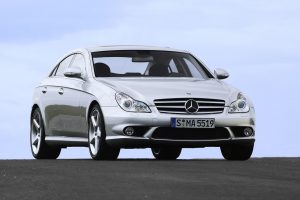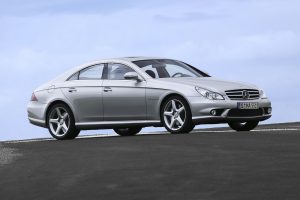Recalls: Mercedes C219 CLS 55 and CLS 63 AMG
Overview
Manufacturers, or importers, issue recalls for defects or faults which have the potential to cause injury. Generally, manufacturers will inform the original buyers if their vehicle is subject to a recall and of the steps required to remedy the defect or fault. Please note that the recalls below (if any) are for Australian-delivered vehicles only. Furthermore, the number of recalls should not be taken as an indication of a model’s reliability or its safety more generally.
Recalls: Mercedes C219 CLS 55 and CLS 63 AMG
2010-11 Mercedes C219 CLS 63 AMG: loss of power steering
In October 2011, a recall was issued for Mercedes C219 CLS-Class vehicles manufactured from November 2010 to April 2011 due to the electric power-assisted steering potentially disengaging; the mechanical steerability, however, would be maintained at all times (PRA 2011/12869).
2010-11 Mercedes C219 CLS 63 AMG: airbag may not fully deploy
In October 2011, a recall was issued for Mercedes C219 CLS-Class vehicles manufactured from November 2010 to May 2011 due to the second stage of the front passenger airbag potentially not deploying as designed; the first stage, however, remained fully operational (PRA 2011/12870).
Mercedes C219 CLS 55 and 63 AMG with sunroof: glass panel may separate
In August 2020, recall campaign RC2752 was issued for Mercedes C219 CLS-Class vehicles that had sunroofs. In these vehicles, the durability of the bonding between the sunroof glass panel and the sliding roof frame may not meet specifications and the glass panel may separate from the vehicle. If this occurred, there was an increased risk of a collision and risk of injury to road users. For the VINs of the recalled vehicles, please see PRA 2020/18467.
2005-10 Mercedes-AMG C219 CLS: glass sunroof panel may detach
In July 2021, recall campaign RC2888 was issued for 2005-10 Mercedes-AMG C219 CLS vehicles. Over time, the bonding of the sunroof glass panel may deteriorate and the glass panel may separate from the vehicle. If the sunroof panel detached, it would increase the risk of a collision and injury for road users. For the VINs of the recalled vehicles, please see REC-001647.
2005-10 Mercedes-AMG C219 CLS-Class: sunroof panel may detach
In February 2023, recall campaign RC3110 was issued for 2005-10 Mercedes-AMG C219 CLS-Class vehicles that were equipped with panoramic glass sliding sunroofs (option code 414). Due to a manufacturing defect, the sliding sunroof panel and frame may not have been bonded correctly. As a result, the sunroof panel may detach from the vehicle. If the panel partially or fully detached from the vehicle, there was an increased risk of injury to road users. For the VINs of the recalled vehicles, please see REC-005621.
Problems and faults: Mercedes C219 CLS 55 and CLS 63 AMG
Overview
This section identifies potential problems, causes and fixes based on the experiences of owners and repairers, online sources and technical service bulletins. This information is provided solely for reference purposes and AustralianCar.Reviews recommends that only properly qualified persons carry out repairs or modifications. Furthermore, the number of items below should not be taken as an indicator of a model’s reliability or the frequency with which they may occur.
To report a problem or fault to the AustralianCar.Reviews team, please use the Contact Us form. Note that AustralianCar.Reviews does not offer advice on automotive problems or disputes; such enquiries will not receive a reply. For vehicles purchased from dealers after 1 January 2011, please see our Australian Consumer Law fact sheet.
M156 engine (CLS 63 AMG): cylinder head bolt failure
For 6.2-litre M156 engines with engines numbers up to 1569xx 60 060658 (corresponding to engines produced from 2006 to the first half of 2010), the cylinder head bolts can stretch and snap.
The M156 engine has ‘torque to yield’ bolts which are designed to achieve a specific clamping pressure by being tightened to a specific torque and then turned a specific number of degrees. To achieve the intended clamping pressure, the upper section of the bolts is designed to stretch slightly. While the exact cause is unclear, it has been suggested that the design of the bolts, their metallurgy or corrosion causes them to stretch and snap.
The failure of one head bolt puts additional stress on the other bolts, causing further failures. The loss of clamping pressure allows coolant and oil to enter the combustion chamber; coolant can also be forced up through the failed head bolt locations into the top of the heads, causing white smoke and a rough idle. In severe cases, the cylinders can experience hydro lock, causing the piston to seize and destroying the entire engine.
Symptoms of head bolt failure are:
- Repeated low coolant levels;
- High oil level (from coolant getting into the oil);
- Illumination of the check engine light (CEL); and,
- White exhaust smoke (burning oil).
To test for head bolt failure, the coolant system could be pressurised and allowed to sit over night to see if the coolant level had dropped and if coolant was present in the oil.
In April 2011, Mercedes-Benz issued service bulletin LI01.30-P-051567 regarding broken cylinder head bolts for the M156 engine which caused coolant to enter the engine oil and/or the combustion chamber. The service bulletin identified the following symptoms:
- CEL (Check Engine Light) illumination;
- Misfire;
- Rough running; and,
- Low coolant indicator illumination.
To fix, the cylinder heads had to be removed so that the piston deck height could be measured. If the measurement from the top surface of the crankcase to the top surface of the piston was outside of specification (the maximum deck height was 0.23 mm), then the affected connecting rod with piston and bearings had to be replaced. As part of the repair, all cylinder head bolts and hydraulic tappets were to be replaced.
M156 V8 engine (CLS 63 AMG): camshaft lobe and valve lifter wear
In a US class action – CEDRIC CHAN v. DAIMLER AG, MERCEDES-BENZ, MERCEDES-BENZ USA, LLC and MERCEDES-AMG GMBH – it was alleged that the combination of nodular cast iron camshafts and valve lifters made of 9310-grade steel resulted in premature wear of the M156 engine as a result of:
- the soft camshaft metal, and/or
- improper heat treating, and/or
- improper camshaft offset.
Specifically, the camshafts were designed so that the lobes would contact the valve lifters. When the camshaft lobes experienced wear, the surface would become rough or scored and no longer make contact with the lifters with the same precision – this would cause the lifters to wear prematurely, demonstrated by a gouged ring in the top of the valve lifter. The gouged ring wear on the buckets also indicated that the buckets were not spinning as intended. The result of this premature wear would be serious engine failure.
Symptoms of camshaft lobe and valve lifter wear include rattling or clattering noises on start-up. In service bulletin S-B 05.20/20b (produced in 2009), Mercedes-Benz acknowledged the problem of camshaft and valve tappet wear. Ultimately, the class action did not proceed due to the plaintiffs’ lack of standing.
Problems and faults: Mercedes C219 CLS 55 and CLS 63 AMG
- The air conditioning may only work intermittently due to a faulty fan/blower.
- Noises from the front brakes may be due to weak brake pad pressure retaining springs.
- The ‘check engine’ light may illuminate due to a bad air pump relay causing a malfunction in the secondary air injection system.
- The speed-sensitive steering may malfunction due to a faulty connector or an electrical fault at the valve on the rack-and-pinion assembly.
- The sunroof may leak or rattle due to an inadequate seal in the frame.
- Water may enter the boot due to a cracked seal.
- The fuse block may get wet due to the lid on the module box not being adequately clamped.
- For early models, the battery could be drained due to a faulty voltage regulator in the alternator.




